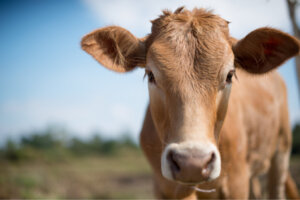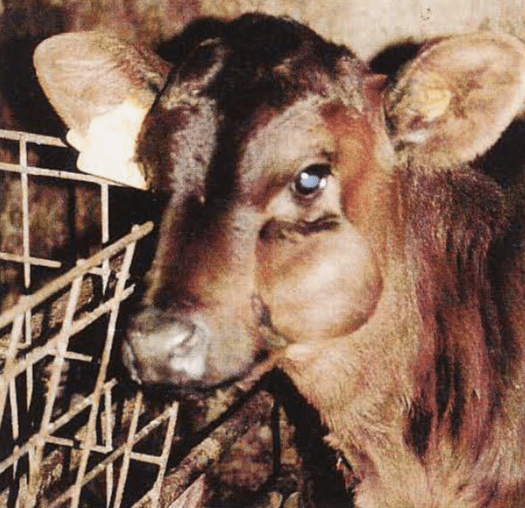Visible Congenital Defects in Domestic Mammals


Written and verified by the vet Érica Terrón González
Congenital defects are structural or functional abnormalities that appear at birth. They are caused by very variable factors, as we will see below.
Congenital defects
Hereditary defects are determined by chromosomal aberrations of mutated genes. These genetic defects are classified as lethal, sublethal, or subvital (compatible with life). Although they occur only once or twice in every 500 births, a significant amount of congenital diseases affect livestock. It’s true that the economic losses involved aren’t too significant, but it does mean financial losses in centers dedicated to the breeding of pedigree animals.
Most congenital defects are visible to the naked eye, and many of them involve stillbirth.
If several births on the same farm involve a congenital defect, an epidemiological investigation is necessary. This investigation should include the history of the mother, her nutrition, diseases suffered, use of medications during gestation, a possible relationship with new cattle and herds.
Some examples of common birth defects in domestic animals
Cleft lip and cleft palate
These are due to a failure of fusion of these structures during fetal development. In addition to being visibly visible, the animal usually shows nasal regurgitation because the oral and nasal cavities are connected. And as a consequence, they can get pneumonias and inhalation of milk.

Spina bifida
This is an absence of the dorsal part of the spine, leaving the spinal cord exposed.
Meningocele or spina bifida occulta
This is a condition in which the bones of the spine don’t close, but the spinal cord and meninges remain in place and the skin usually covers the defect, forming a sac.
Mucocele
This is an extravasation of saliva into the subcutaneous tissues from a rupture in the duct of a salivary gland.

Achondroplasia or dwarfism
This occurs due to an error in cartilage growth. In calves, it’s referred to as a “bulldog” appearance, because they have a short, overly broad head, short legs, and a plump abdomen.
Anasarca
This is known as edema, generalized fluid accumulation throughout the body.
Hydrocephalus
The skull increases in size due to excessive pressure caused by an abnormal volume of cerebrospinal fluid. Apart from being a congenital problem, it can occur in adult individuals following infection or contusion.
Vertebral fusion and kyphosis
Normally, almost all of the cervical, thoracic, and lumbar vertebrae are affected. The appearance will be of a shortened neck and excessive curvature of the spine.
Syndactyly
This is the fusion of the toes or hooves. It’s relatively common in dairy calves.
Imperfect epitheliogenesis
A congenital absence of the outer layer of skin, leaving the lower tissues exposed. They are usually aggravated by bleeding and infections of these tissues, which can cause septicemia and death.
Hypotrichosis
Slow hair growth from birth. It appears thinner and weaker, and there may even be areas with bald patches. It is also known as “bald calf syndrome”.
Parakeratosis
This is the abnormal thickening of the skin, which appears scaly, irritated, and with fissures. The tissue immediately underneath appears inflamed.
As you could read in this article, there are many congenital defects that can affect animals and whose causal factors can be genetic, environmental, toxic, infectious, etc.
Congenital defects are structural or functional abnormalities that appear at birth. They are caused by very variable factors, as we will see below.
Congenital defects
Hereditary defects are determined by chromosomal aberrations of mutated genes. These genetic defects are classified as lethal, sublethal, or subvital (compatible with life). Although they occur only once or twice in every 500 births, a significant amount of congenital diseases affect livestock. It’s true that the economic losses involved aren’t too significant, but it does mean financial losses in centers dedicated to the breeding of pedigree animals.
Most congenital defects are visible to the naked eye, and many of them involve stillbirth.
If several births on the same farm involve a congenital defect, an epidemiological investigation is necessary. This investigation should include the history of the mother, her nutrition, diseases suffered, use of medications during gestation, a possible relationship with new cattle and herds.
Some examples of common birth defects in domestic animals
Cleft lip and cleft palate
These are due to a failure of fusion of these structures during fetal development. In addition to being visibly visible, the animal usually shows nasal regurgitation because the oral and nasal cavities are connected. And as a consequence, they can get pneumonias and inhalation of milk.

Spina bifida
This is an absence of the dorsal part of the spine, leaving the spinal cord exposed.
Meningocele or spina bifida occulta
This is a condition in which the bones of the spine don’t close, but the spinal cord and meninges remain in place and the skin usually covers the defect, forming a sac.
Mucocele
This is an extravasation of saliva into the subcutaneous tissues from a rupture in the duct of a salivary gland.

Achondroplasia or dwarfism
This occurs due to an error in cartilage growth. In calves, it’s referred to as a “bulldog” appearance, because they have a short, overly broad head, short legs, and a plump abdomen.
Anasarca
This is known as edema, generalized fluid accumulation throughout the body.
Hydrocephalus
The skull increases in size due to excessive pressure caused by an abnormal volume of cerebrospinal fluid. Apart from being a congenital problem, it can occur in adult individuals following infection or contusion.
Vertebral fusion and kyphosis
Normally, almost all of the cervical, thoracic, and lumbar vertebrae are affected. The appearance will be of a shortened neck and excessive curvature of the spine.
Syndactyly
This is the fusion of the toes or hooves. It’s relatively common in dairy calves.
Imperfect epitheliogenesis
A congenital absence of the outer layer of skin, leaving the lower tissues exposed. They are usually aggravated by bleeding and infections of these tissues, which can cause septicemia and death.
Hypotrichosis
Slow hair growth from birth. It appears thinner and weaker, and there may even be areas with bald patches. It is also known as “bald calf syndrome”.
Parakeratosis
This is the abnormal thickening of the skin, which appears scaly, irritated, and with fissures. The tissue immediately underneath appears inflamed.
As you could read in this article, there are many congenital defects that can affect animals and whose causal factors can be genetic, environmental, toxic, infectious, etc.
All cited sources were thoroughly reviewed by our team to ensure their quality, reliability, currency, and validity. The bibliography of this article was considered reliable and of academic or scientific accuracy.
- Meningocele [Internet]. Es.wikipedia.org. [cited 8 October 2019]. Available from: https://es.wikipedia.org/wiki/Meningocele
- Anasarca [Internet]. Es.wikipedia.org. [cited 8 October 2019]. Available from: https://es.wikipedia.org/wiki/Anasarca
- Mucocele [Internet]. Es.wikipedia.org. [cited 8 October 2019]. Available from: https://es.wikipedia.org/wiki/Mucocele
- Blowey R, Weaver A. Color atlas of diseases and disorders of cattle. Edinburgh: Mosby; 2012. Pág: 1-10
This text is provided for informational purposes only and does not replace consultation with a professional. If in doubt, consult your specialist.








